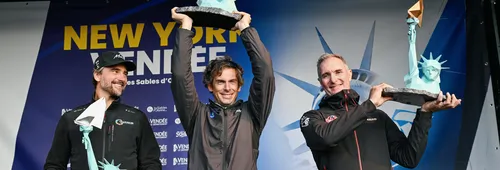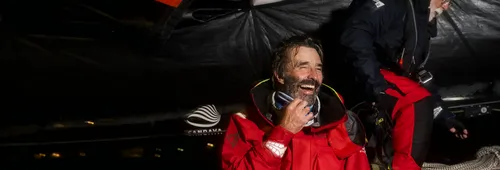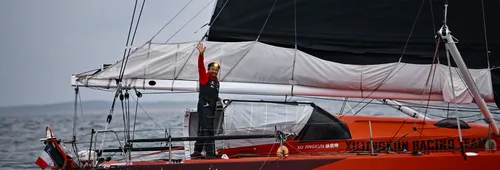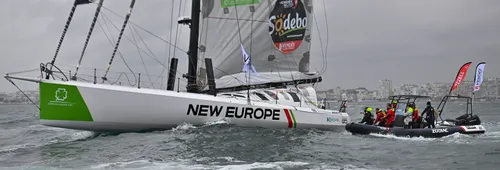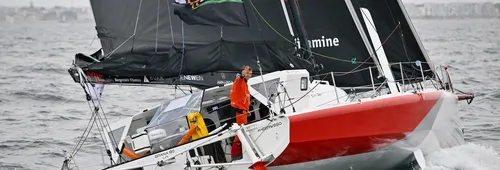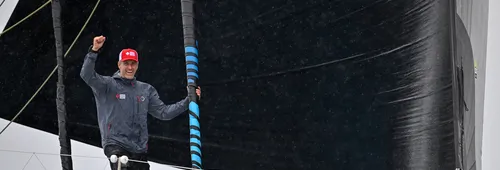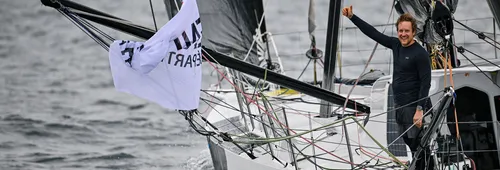Wednesday’s start for the New York Vendee – Les sables d’Olonne will be unique for an ocean race: it will be so far out at sea that only the skippers and their IMOCA 60s will be there, not shore crew, no spectators, no starting marks.
The Skippers left the docks in New York and Newport Tuesday afternoon to make their way to the waypoint approximately 90 miles from the harbors. Some stayed ashore to rest while boat crews tested equipment off the coast, waiting to be shuttled out for the overnight sail to the start.
The skippers, their crews and fans waiting online will have to be patient to watch onboard cameras documenting the start Wednesday at 8 p.m. French time, 2 p.m. local time.
The weather forecast shows a confusing pattern with light winds overnight Tuesday into start day. Then a barrage of uncertain weather features have teams waiting to the last minute to decide their route.
Their stay in the United States is coming to an end. It’s time to put away in the memory box the moments they experienced here, so far from their daily life as sailors. From now on, everyone's eyes are turned towards the competition, this New York Vendée – Les Sables d'Olonne and its some 3,200 theoretical miles (59,300 km) to be covered from one end of the Atlantic to the other. At the start of the morning, the technical teams made the final preparations, checked the equipment and supplies one last time and carried out a final study of the weather.
The remote starting location is something the skippers have been contemplating the past weeks, figuring their timing for the departure and have even made weather routing to plan their approach.
The starting line decision aims to avoid as much as possible the risk of collisions with marine mammals. Other initiatives have been taken in this direction: a recommendation to sail to the start at reduced speed, a biodiversity protection zone has been determined in the North and a waypoint – the Share the Ocean waypoint – will force sailors to head towards the South after the start. Enough to allow skippers to focus on the race and do everything to exploit the maximum potential of their boat.
SKIPPER’S FEELINGS LEAVING THE DOCKS TUESDAY
Clarisse Cremer (l’Occitaine): “I won’t be super busy once I’m alone. I will be raising sails for the first few hours. I am worried about miles for being selected. This is determining my strategy. I just have to finish. Still I want to push but I have to be cautious. Some will be pushing hard to test their boats and win. I can’t really think like that. I have prepared the boat differently, just for my goal. I have the older, stronger foils and I will have no forward ballast tanks since we still have a repair. That will hurt me because there will be a lot of upwind. Taking a nap before and then heading out at six feels like the safer option.”
Benjamin Dutreaux (GUYOT Environment): “What’s left? Nothing more! Charles and Axel will wait in the bay until 6 p.m. to test some systems. I will then spend the night alone. But right before they step off we will share a meal together and share notes. I’m very happy to be alone again. It’s more pressure, but I like it. We have updated the boat every year and I’m ready to race.”
Kojiro Shiraishi (DMG Mori Global One): “The most important thing for me is to not break anything and be safe in France. I full trust in all my crew and they all have given their best in all the races we do. It’s good teamwork. Of course it’s a particular start, it’s not always. I will take all the time I need to get to the start safely. I will go slowly but surely to be there safe and sound. I have lots of books and music to keep me occupied.”
Denis Van Weynberg (D’ieteren group): “The state of mind is obviously good because we’re going home! We know that a solo transatlantic race is far from being a long, quiet river, and that we will have to be vigilant, especially as I have a small crack in the mast. But it’s just fun! I can't wait to find this tranquility alone at sea. Being qualified for the Vendée Globe and having conditions that are a little light at the start allows you to be a little more serene than usual. Then, we will have to see how we get around the anticyclone, we should see more clearly this weekend. »
Manuel Cousin (Coup de Pouce): “I lived a dream here. For a sailor, coming to New York by boat is a very strong marker, as can be the passage of Cape Horn. I had a great time here, the sponsors were delighted. I can't wait to cross the starting line, that will mean that I am qualified for the Vendée Globe. You will have to be vigilant: it is like a finish line, as long as it is not crossed, nothing is decided. Afterwards, I could focus on the sporting aspect. I want to have a good race to gain some peace of mind before the Vendée Globe. The next 24 or even 48 hours are not going to be easy for sleep. You will have to be on constant watch to avoid collisions and watch out for the mist. »
Romain Attanasio (Fortinet): “This start will allow us to settle in, not to experience the rush of classic starts. My goal in racing is to be “offensively cool”, while ensuring that the boat is preserved. Afterwards, if there is a possibility of making a good place in the ‘top 10’, I won’t deprive myself of it! From the start line to the first buoy, conditions will be fairly calm downwind. You will have to look for the wind, stay in the Gulf Stream, without knowing if it will be between 6 to 8 knots or between 2 and 4 knots. After three days, there will be a crosswind, from the South and it should therefore bombard on flat seas. Then there are more uncertainties with a huge anticyclone which will force us to look for a gull wing with a headwind. »
Yoann Richomme (Paprec Arkéa): “I’m in a rather peaceful state of mind. The poor conditions at the start will allow you to be more calm and approach the race calmly. Tonight I might watch a movie or series I downloaded, eat well and try to sleep well too! During the race, there will be lots of little tricks to play, it looks really interesting. And then I like to get off to a good start, to be at the forefront from the outset.”
Samantha Davies (Heart Initiatives): “I can’t wait to go! We really enjoyed New York but I really want to get back on the water and take part in another fight within the IMOCA fleet. I'm going to take a nap this afternoon while my technical team is still on board and I'll head out to sea when night falls. A calm start is a change from what we had during the last two races. It's going to be great to face these conditions and find the right settings to perform.
Justine Mettraux (Teamwork – Team Snef): “We know that we are going to start in fairly easy conditions. Before then, we will have time to gradually get into the race. I will try not to waste too much time before reaching the starting line to try to rest as much as possible. Initially, conditions will be weak until the waypoint. Then, it all depends on the speed we will have in this soft zone before hitting the stronger winds. Afterwards, we will have to manage to get around a small depression to position ourselves to the east and it is difficult to know when and how we will manage to do so. For the moment, it remains difficult to plan ahead. We should leave for 9 to 11 days depending on the model. »
Sébastien Simon (Groupe Dubreuil): “The departure from the pontoon went well despite the currents and the wind. I board a semi-rigid boat with my partners to join the boat in the afternoon. Spending time on the water before departure is always a little stressful. My goal then is to go relatively quickly to the starting line because there is no wind during the night. This departure will be a little special since we will all be offshore in calm conditions. They will perhaps be a little more muscular with a frontal passage a few days later. But the rest of the transatlantic race looks very calm even if there could be surprises at the end. It’s a transatlantic race that promises to be very technical and strategic.”


